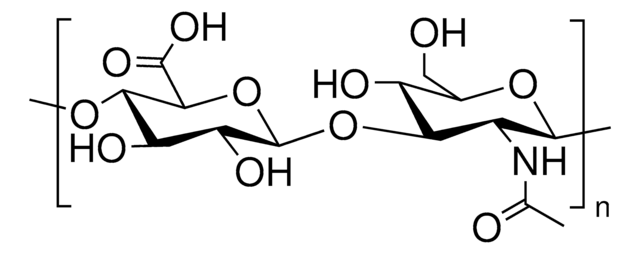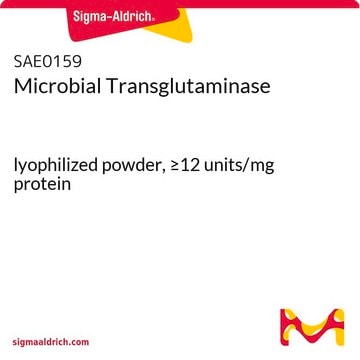H6268
Hide–Remazol Brilliant Blue R
protease substrate, powder
Synonym(s):
Hide powder azure, Remazol Brilliant Blue R–Hide
Sign Into View Organizational & Contract Pricing
All Photos(2)
About This Item
Recommended Products
Product Name
Hide–Remazol Brilliant Blue R, protease substrate
Quality Level
form
powder
storage temp.
2-8°C
Looking for similar products? Visit Product Comparison Guide
Application
Hide−Remazol Brilliant Blue R has been used:
- to study the substrate specificity of a purified collagenase preparation from Clostridium histolyticum
- to mix with cytotoxic samples for hide powder azure protease activity assay
- as a high molecular weight substrate to test the inhibition of trypsin by the purified recombinant rat bikunin, α1-m/bikunin precursor, and α1-m
- as a substrate to obtain the inhibition of snake venom protease activity by the addition of exogenous citrate
Other Notes
Hide powder covalently linked to Remazol Brilliant Blue R
Substrates
Chromogenic substrate for trypsin
Storage Class Code
11 - Combustible Solids
WGK
WGK 3
Flash Point(F)
Not applicable
Flash Point(C)
Not applicable
Personal Protective Equipment
dust mask type N95 (US), Eyeshields, Gloves
Choose from one of the most recent versions:
Already Own This Product?
Find documentation for the products that you have recently purchased in the Document Library.
Customers Also Viewed
Citrate inhibition of snake venom proteases
Odell G V, et al.
Toxicon, 36(12), 1801-1806 (1998)
Soluble, dye-labelled substrates for a micro-plate assay of proteinase activity
Wolf G A and Wirth S J
Journal of Microbiological Methods, 25(3), 337-342 (1996)
Expression of a functional proteinase inhibitor capable of accepting xylose: bikunin
Falkenberg C, et al.
Archives of Biochemistry and Biophysics, 387(1), 99-106 (2001)
S Mischke
Microbios, 87(352), 175-183 (1996-01-01)
Four chromogenic substrates were compared, and methods were developed for measuring protease activity from fungi. Digestion of azoalbumin, a water-soluble substrate, resulted in dye release most closely proportional to enzyme activity. Substrates insoluble in water were advantageous for time-course studies
J Melrose et al.
Archives of orthopaedic and trauma surgery, 114(3), 145-152 (1995-01-01)
Chemonucleolysis is a therapeutic procedure whereby a degradative enzyme is injected intradiscally to reduce disc height/width by depolymerisation of extracellular matrix components. This process is considered to diminish disc pressure on inflamed nerve roots, resulting in the alleviation of sciatic
Our team of scientists has experience in all areas of research including Life Science, Material Science, Chemical Synthesis, Chromatography, Analytical and many others.
Contact Technical Service










